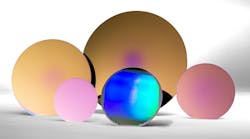A new way to make materials, known as sequential infiltration synthesis (SIS), could improve chip making, hard-drive storage, solar cell efficiency, anti-reflective surfaces on optics, and water-repellant windows and car windshields. The idea behind it was conceived in 2010 during a lunchtime conversation between four researchers at Argonne Laboratory
The method was based on the group’s discussion of atomic layer deposition, or ALD, a thin film deposition technique that uses alternating chemical vapors to grow materials one atomic layer at a time. It was recently used to add a water-loving metal oxide coating to filters used in the oil and gas industry which prevents the filters from clogging.
Then the same group of researchers wanted to take ALD to a new level, which would become SIS.
“We wanted to grow one material inside another material like a polymer instead of on top of it,’” says director of the Institute for Molecular Engineering at Argonne, Seth Darling. “We first thought ‘This isn’t going to work,’ but, surprisingly, it worked beautifully on the first try. Then we began imagining all of the different applications it could be used for.”
SIS is similar to ALD on a polymer surface, but in SIS vapor is diffused into the polymer rather than on top of it, and it chemically binds with the polymer and eventually grows to create inorganic structures throughout the entire polymer bulk.
Using this technique, scientists can create durable coatings that can help semiconductor manufacturers incorporate more intricate features on computer chips, letting them be even smaller or add extra storage and other capabilities. They can also tailor the shape of various metals, oxides, and other inorganic materials by applying them to a polymer with SIS and then removing the remains of the polymer.
“You can take a pattern in a polymer, expose it to vapors, transforming it from an organic material to an inorganic material,” says Jeffrey Elam, director of Argonne’s ALD research program, as he describes how SIS uses polymers and a vapor to basically mold new materials with specific properties. “It’s a way to use a polymer pattern and convert that pattern into virtually any inorganic material. Engineers can use SIS to create a film and put it on a metal, or create one on glass or put it on a glass windshield to make it water repelling to the point you don’t need wipers.”
The technique also addresses a specific concern in the semiconductor manufacturing industry, pattern collapse, which means the collapse of tiny features used to create electrical components on a computer chip—rendering it useless.
When a pattern is etched onto a silicon chip during the chip-making process, an etch-resistant surface serves as a protective coating to mask regions you do not want removed. But the etch-resistant coatings commonly used wear away quickly, which has prevented chip manufacturers from making components with deeply etched features.
With SIS, inorganic vapor coatings can be engineered to better protect vertical features, allowing for deeper etches and putting more components on each chip.
“Features on chips have gotten extremely small laterally, but sometimes you also want to make them tall,” says Darling “You can’t make a tall feature if the resist etches away quickly, but with SIS it’s easy.”
Similarly, the technique can be used to manipulate magnetic recording on hard drives or other storage devices, letting manufacturers increase storage while also making the drives smaller, Darling adds.
Another possibility for the technology is to control how much light bounces off a glass or plastic surface. Using SIS, scientists can engineer surfaces to be almost entirely non-reflective. Using this strategy, scientists can improve performance of solar cells, LEDs and even eyeglasses.

